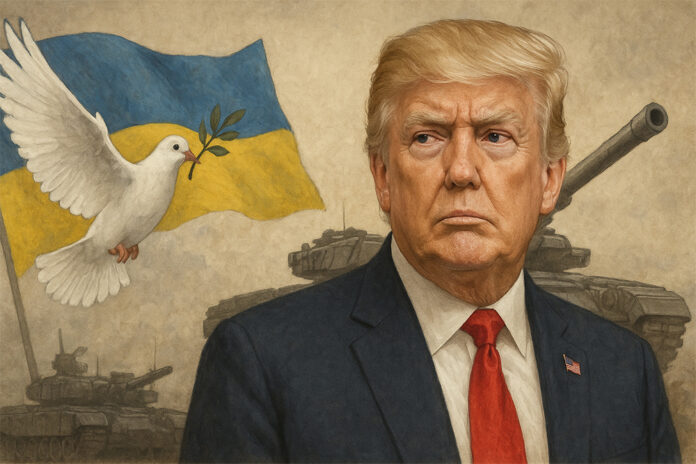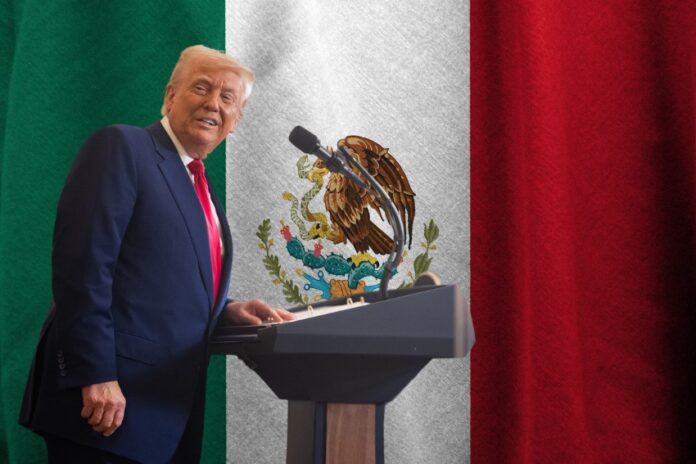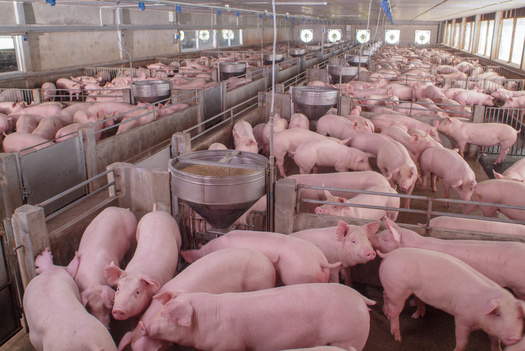The narrative over Ukraine reveals not only how hard the war economy will fight to rescue its system from peace, but also how the hardest sell these days is hard reality
by Frank Wright
(LifeSiteNews) — The Trump administration’s moves toward peace in Ukraine – and elsewhere – have attracted widespread criticism from within and without the globalist establishment.
As the U.S. government now threatens to “walk away” from Ukraine if its seven-point peace plan is rejected, a new battle line is being drawn between permanent war and propaganda – and the urgent reality demanding radical change from the globalist business as usual.
Trump has proposed an immediate ceasefire, no NATO membership for Ukraine, and for Russia to keep the territories it has taken during the war – with the U.S. to recognize Crimea as Russian. The proposal for peace has been met with outrage, and even accusations of betrayal. Yet the peace deal appears to be a simple recognition of reality. What’s the problem?
Dan Davis’ deep dive into Ukraine
In his deep dive of April 23, Dan Davis helps to explain why reality is so controversial and the mention of peace akin to treason. He joins German journalist and academic Patrik Baab to show how the pro-war faction in the U.S. and Europe have fought their own line in the media for well over a decade.
Davis, whose appointment to a National Intelligence post was recently sabotaged by another war faction – that of the Israel lobby – has learned the personal consequences of contradicting the globalist war narrative. So has Baab – who was fired from his academic post in 2022 for the crime of journalism.
Baab had traveled to Donbass to research a now published book he discusses with Davis. Titled On Both Sides of the Front, it informs his discussion of the “NATO-backed Maidan coup” in 2014 and the media campaign which has sold this war to Westerners as yet another defence of democracy abroad – as in Iraq. According to Foreign Policy, Ukraine is a magical democracy which “still functions without elections.”
Having arrived at the time of the Russian-backed elections in Donetsk and Lugansk regions, Baab was accused on his return to Germany of having “legitimized” the votes and was dismissed and smeared in the German press.
Both Davis and Raab give important context to U.S. threats to “walk away” from Ukraine if a peace deal is not settled, showing the reason why “two different stories” are so often told “about the same events.”
Reality vs. fantasy, or life and death
In Western politics and media, one side is invested in the war and the other is not. This can also be seen as the factions of fantasy versus reality.
The globalist faction has told us the Russians were losing, that Putin was dying, that there would be “total victory” for Ukraine and no negotiations until Putin was toppled. Zelensky issued a decree forbidding negotiations with Russia.
EU Chief Commissioner Ursula von der Leyen famously claimed in 2022 that Russia was cannibalizing “refrigerators and washing machines” to harvest microchips for its war machine, with the UK defense minister saying in early 2023 that Russian soldiers had been reduced to fighting with shovels. In the media, Ukraine’s victory was only a matter of time – which was money. Yours.
To keep this money flowing, the Western audience whose taxes provide it must be convinced there is good reason to keep sending it to Zelensky, who cannot pay it back.
U.S./NATO started the war
As Baab explains, the reason why the global faction arranged this war was nothing to do with Ukraine – the objective was to collapse and balkanize Russia. This would give the globalist British state and its pro-war EU partners a new lease of geopolitical life, as well as shoring up their crippled economies with command of Russia’s near limitless natural resources.
A global war industry
Former U.S. Secretary of State Antony Blinken ran WestExec – a profitable war business consultancy, one of many which monetized forever war through influence peddling.
Former under-secretary of state Victoria Nuland, who managed the 2014 coup in Ukraine, has her own family business of war. It is called “the Kagan-industrial complex” after her husband arch-neocon Robert Kagan and his brother Frederick – whose ISW urges escalation in the talking points it supplies to pro-war outlets in the mainstream media. This network runs public relations for the wars its members start. Nice work if you can get it.
Russia has won
This is the reality behind the slogans of “Slava Ukraini” and the framing of the war as the defense – and inevitable triumph – of “democracy.” This fantasy narrative is now collapsing. Why?
In reality, Russia has won the war. As Baab points out, “Putin won the war. That means the West has to meet Putin’s proposals.”
This reality is a problem for the Western media which has sold every disastrous war of the last century as a win and a sacrifice in the defense of democracy. It is also a problem for the liberal-global elite, whose political capital is invested in the defeat of Russia.
U.S. will ‘walk away’ if no deal
U.S. Secretary of State Marco Rubio – together with Vice President JD Vance – have said that if Trump’s seven-point plan is not accepted the U.S. will “walk away” from Ukraine – as retired Colonel Douglas Macgregor has consistently said they should.
Neither Rubio nor chief negotiator Steve Witkoff attended the London conference on April 23, at which Zelensky predictably rejected Trump’s seven-point peace deal.
Col. Macgregor told Judge Andrew Napolitano it was clear “Zelensky is not going to agree” to the proposed deal.
Why? It is based on reality. Macgregor agrees that the U.S. should walk away – reminding viewers “this war would never have happened had we not mightily supported this regime we helped into power in 2014.”
Why did the U.S. do that? “To attack Russia,” Macgregor says, “because the whole idea was to build up a Ukrainian battering ram and hurl it at Russia. Crazy.”
A frustrated and uncharacteristically alarmed Macgregor asks, “Why are we even involved?”
He suggests “the best President Trump can do is say ‘It’s over. I never wanted this. It’s not my war. I’m suspending all aid, I’m pulling out.’”
The former Trump adviser adds, “Well, he didn’t do that. What’s next? I’m not sure.”
“Whatever happens, we look ridiculous. Again.”
Macgregor adds that “at least we have had the sense to walk away. What’s important is to normalize relations with Moscow,” explaining that Zelensky’s claims to Crimea and the Russian regions now absorbed into Russia are “nonsense.”
Trump: recognizing reality?
The Trump administration has offered to recognize Crimea as Russian – as has been historically and actually the case. Trump himself has accused Zelensky of sabotaging the peace deal, as the unelected leader of Ukraine refuses this and other concessions made unavoidable by the fact that Russia has won the war.
“The situation for Ukraine is dire – He can have Peace or, he can fight for another three years before losing the whole Country. I have nothing to do with Russia, but have much to do with wanting to save, on average, five thousand Russian and Ukrainian soldiers a week, who are dying for no reason whatsoever.”
Trump laid the blame squarely on Zelensky – saying his impossible demands would simply prolong the killing, as well as resulting in total defeat.
“The statement made by Zelenskyy today will do nothing but prolong the ‘killing field,’ and nobody wants that! We are very close to a deal, but the man with ‘no cards to play’ should now, finally, GET IT DONE.”
In 2014, Crimeans voted “overwhelmingly” to secede from Ukraine and rejoin Russia. The territory was gifted to the Ukrainian Soviet Republic by Nikitia Khrushchev in 1954, though its population remained predominantly ethnic Russian.
Trump’s aim, as Alastair Crooke has pointed out, is far bigger than merely ending this war. The overall goal here is a reset of the global order – away from the death cult model of forever war, and toward stabilization and trade abroad to power national renewal at home. As Crooke notes, Trump “is ringed by a resolute domestic enemy front in the form of an ‘industrial concern’ infused with Deep State ideology, centered primarily on preserving U.S. global power (rather than on mending of the economy).”
Surrender to Russia?
Reports in the globalist media of a total surrender to Russia are overblown:
Trump countered the narrative of “concessions” to Russia with the stark riposte that Russia’s choice not to “take all of Ukraine” was a significant concession in itself.
As Alex Christoforou of The Duran noted, Trump’s position on Crimea presented the EU with a “choice,” which the globalist Financial Times says was “forced” upon the pro-war bloc.
Russians propose alliance with U.S.
So what do the Russians think?
A remarkable response from the Russians shows some of their perspective. On April 16, the Russian Foreign Intelligence Service (SVR) published a call for Washington and Moscow to unite against the EU – and to thwart the moves of the British state to escalate and prolong the war.
According to RT, the statement said, “The US and Russia are natural allies against ‘Eurofascism’ and the tyrannical tendencies prevalent in Western European countries.”
From its beginning, the EU has tended to be a totalitarian entity, ruled over by unelected, globalist-minded bureaucrats and elites determined to crush the unique cultures and sovereignty of its member states. Many have warned that that it was created to be the springboard for a New World Order tyranny.
The SVR sounded an optimistic note, suggesting Russian and U.S. officials are working together to secure peace.
“The agency said that ‘foreign expert circles’ are hopeful that Russia and the US will work together to prevent ‘a new global conflict’ and confront ‘possible provocations both from Ukraine and from the “maddened Europeans” traditionally urged on by Great Britain.’”
As Davis and Baab discussed, neither Steve Witkoff nor Marco Rubio attended the recent London conference on Ukraine – which Macgregor said was pointless due to Zelensky’s refusal to accept reality.
British state vs. Trump peace deal
British Prime Minister Keir Starmer has joined the EU in “contradicting” Trump, according to the Daily Telegraph. Starmer says the unelected Zelensky must have a say in any deal – and Zelensky is of course saying no.
The Daily Telegraph blasted Trump’s seven-point peace plan as “surrender, capitulation, betrayal, appeasement,” saying “Trump’s deal” to secure peace “would plunge the world into war” by “rewarding aggression” and “overturning [the] rules-based order.”
War is the rule of the ‘rules-based order’
It was the “rules-based order” which expanded NATO in the 1990s, against George Kennan’s 1997 warning of this “fateful error” – which would provoke war with Russia.
Kennan predicted that moving NATO’s borders 300 miles eastward would make conflict with Russia inevitable, describing it as “the most fateful error of American policy in the entire post-Cold War era.”
This was no error. The collapse and plunder of Russia and its absorption into the global empire appears to have been the intention all along.
War has been the rule on which the rules-based order is based, as independent journalists have reported for years. This is why it is no surprise to hear the remnants of that order in Europe and in Britain demonize any attempts at peace – as treason.
British state determined to prolong war
The British state is determined to escalate and prolong the war. GrayZone journalist Kit Klarenberg has documented the consistent efforts of the UK Deep State to do so and returned this week with a report detailing how a secret government unit has been directing military operations in Ukraine and in Russia – supporting a strategy of continuing the war even after any ceasefire.
Does Trump have a plan?
Despite Colonel Macgregor’s complaint that he sees “no grand strategy” in the Trump administration, it is clear that the old one is dissolving. As the Trump administration’s peace proposals show, the one which will replace it relies on securing normalized relations – and trade – with Russia, instead of a perpetual march to world war trailered in Western media as inevitable.
The Trump administration has invited howls of outrage for its “surrender” to Russia in pursuing direct negotiations to end the war in Ukraine, as well as over its secret talks from before day one with Iran to avert a major conflict planned by another war faction: the Israel lobby.
The move away from the economic model of the liberal global system is a move away from an economic model of permanent war. This forever war model is waged against your Christian civilization at home in the mass media and the culture it transmits, as much as its business model bombs nations abroad.
Significant interests are being mobilized to prevent this move. Trump needs a win on the domestic front in this perilous moment of the detransition from globalism. The U.S. can no longer afford these foreign commitments – it is facing financial, moral, and diplomatic bankruptcy as the fantasy project of world domination hits real life limits.
The narrative over Ukraine reveals not only how hard the war economy will fight to rescue its system from peace, but also how the hardest sell these days is hard reality.
Independent voices like Davis, Macgregor, and that of The GrayZone show some of the terms and conditions of the devil’s bargain we are so often sold in the mainstream media. The Trump grand strategy appears to be a return to reality, to the value of life and the God-given natural order of our formerly Christian civilization. The devil is not only in the details revealed by the likes of Davis – his legions are fighting to defend the business model of death we are sold as “liberal democracy.”
Vance says he is “optimistic” that a deal will be made. If peace breaks out, the howling in the media will show you whose side they are on, and whose work they wish to do in the world.












